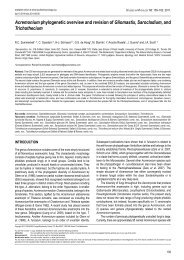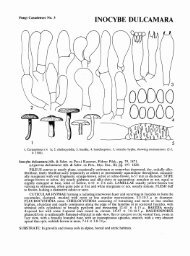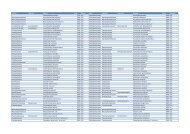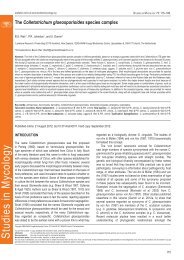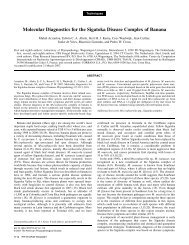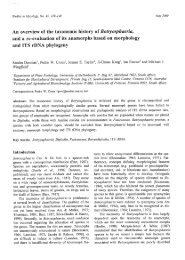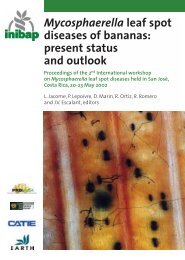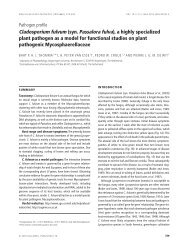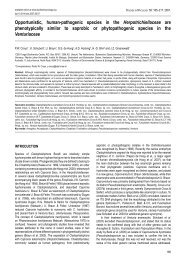Hypocrea rufa/Trichoderma viride: a reassessment, and ... - CBS
Hypocrea rufa/Trichoderma viride: a reassessment, and ... - CBS
Hypocrea rufa/Trichoderma viride: a reassessment, and ... - CBS
Create successful ePaper yourself
Turn your PDF publications into a flip-book with our unique Google optimized e-Paper software.
<strong>and</strong> Putzentalalm, MTB 8749/1, 47°17’12’’ N, 13°52’13’’ E, elev.<br />
1170 m, on log segment of Picea abies, 100 cm thick, in grass, soc.<br />
Nectria fuckeliana, 6. Aug. 2003, H. Voglmayr & W. Jaklitsch, W.J.<br />
2306 (WU 24018; culture <strong>CBS</strong> 119324 = C.P.K. 942); (Ost-)Tirol:<br />
Lienz, Defereggental, Hopfgarten in Defereggen, in Dölsach, at<br />
roadside between the current transformer <strong>and</strong> the beverage depot,<br />
MTB 9041/3, 46°55’23’’ N, 12°32’41’’ E, elev. 990 m, on stored log<br />
of Picea abies, 16 cm thick, in grass, 4. Sep. 2003, W. Jaklitsch,<br />
W.J. 2374 (WU 24019; culture C.P.K. 947); Vienna, 23 rd district,<br />
Maurer Wald, MTB 7863/1, 48°08’57” N 16 14’50” E, elev. 360 m,<br />
on decorticated branch of Carpinus betulus on the ground, in mixed<br />
deciduous forest, soc. Tubeufia cerea, 3 Oct. 1998, W. Jaklitsch,<br />
W.J. 1223 (WU 24009, BPI 747557; culture G.J.S. 98-182 = <strong>CBS</strong><br />
120067). France, Haute Garonne, Bord de la Garonne, 31000<br />
Toulouse, on bark of Carpinus sp., 11 Dec. 1994, J.F. Magni, comm.<br />
F. C<strong>and</strong>oussau (BPI 737860; culture G.J.S. 94-118 = IMI 374788);<br />
Pyrénées Atlantiques, Isle de Sauveterre de Bearn, elev. 100 m, on<br />
bark of recently dead tree, 25 Oct. 1998, G.J.S. & F. C<strong>and</strong>oussau<br />
(BPI 748308; culture G.J.S. 98-129 = <strong>CBS</strong> 101928). Germany,<br />
Baden-Württemberg, Freiburg, L<strong>and</strong>kreis Schwarzwald-Baar-Kreis,<br />
Furtwangen, shortly before Kaltenherberg coming from Gasthof<br />
Thurner, MTB 8015/1, 47°59‘36‘‘ N, 08°10‘50‘‘ E, elev. 1000 m, on<br />
mostly decorticated cut logs of Picea abies, 20–40 cm thick, in a<br />
pile in grass at road side, part with white mould, 2 Sep. 2004, W.<br />
Jaklitsch & H. Voglmayr, W.J. 2664 (WU 24023; culture C.P.K. 2138);<br />
Freiburg, L<strong>and</strong>kreis Breisgau-Hochschwarzwald, St. Märgen, shortly<br />
after Glashütte, coming from Hexenloch, on the right side of the road<br />
close to a bridge, MTB 8014/2, 47°59’37’’ N, 08° 07’32’’ E, elev. 750<br />
m, on mostly decorticated cut branch of Picea abies, 4 cm thick, on<br />
very moist ground, 2 Sep. 2004, H. Voglmayr & W. Jaklitsch, W.J.<br />
2665 (WU 24024; culture C.P.K. 2044); Freiburg, L<strong>and</strong>kreis Lörrach,<br />
Todtnau, at the crossing to St. Blasien, MTB 8113/4, 47°48’11’’ N,<br />
07°56’01’’ E, elev. 490 m, on mostly decorticated cut logs of Picea<br />
abies, up to 35 cm thick, in pile, wet, in grass, soc. old Ophiostoma<br />
sp., white mould, 3 Sep. 2004, W. Jaklitsch & H. Voglmayr, W.J. 2670<br />
(WU 24025; culture <strong>CBS</strong> 119323 = C.P.K. 2045); Bavaria, Starnberg,<br />
Tutzing, Erling, at the Hartschimmel terrain, 47°56’41’’ N, 11°10’37’’ E,<br />
elev. 700 m, on partly decorticated branch of Fagus sylvatica, 13–15<br />
cm thick, on the ground deep in leaf litter, 3 Sep. 2005, W. Jaklitsch,<br />
W.J. 2838 (WU 24028; culture C.P.K. 2139). Sweden, Stockholms<br />
Län, Nothamn, mixed forest at the coast, MTB 4179/3, 60°01’42’’ N,<br />
18°50’46’’ E, elev. 10 m, on corticated branch of Corylus avellana, 2–<br />
2.5 cm thick, in moss in mixed forest of Picea abies, Pinus sylvestris,<br />
Betula pendula, Corylus avellana, Sorbus aucuparia, soc. Diatrype<br />
stigma s.l., 7 Oct. 2003, W. Jaklitsch, W.J. 2447 (WU 24020; culture<br />
C.P.K. 983); Uppsala Län, Sunnersta, forest opposite the virgin forest<br />
Vardsätra Naturpark across the main road, MTB 3871/2, 59°47’24’’ N,<br />
17°37’51’’ E, elev. 15 m, on cut branch of Salix caprea, 7.5 cm thick,<br />
on bare, very moist soil in mixed forest, soc. Capronia cf. pilosella, 8<br />
Oct. 2003, W. Jaklitsch, W.J. 2453 (WU 24021; culture C.P.K. 985).<br />
United Kingdom, Devon, Exeter, Stoke Woods, close to the parking<br />
place Forest Walks, SX919959, 50°45’10” N, 03°31’54” W, elev. 30<br />
m, on mainly corticated branch of Fagus sylvatica, 4 cm thick, on<br />
the ground in leaf litter, 8 Sep. 2004, H. Voglmayr, W. Jaklitsch & J.<br />
Webster, W.J. 2686 (WU 24026; culture C.P.K. 2046); North East<br />
London, Epping Forest, between Robin Hood Roundabout <strong>and</strong> Hill<br />
Wood, 43–34/1, 51°39’15” N, 00°02’13” E, elev. 40 m, on branch<br />
of Fagus sylvatica on the ground in leaf litter, soc. <strong>and</strong> partly on a<br />
resupinate polypore, soc. <strong>Hypocrea</strong> lixii, Ascocoryne sarcoides,<br />
Diatrype decorticata, 16 Sep. 2004, H. Voglmayr & W. Jaklitsch,<br />
W.J. 2723 (WU 24027; culture <strong>CBS</strong> 119322 = C.P.K. 2047). United<br />
States, North Carolina, Macon Co., Nantahala National Forest, W of<br />
Franklin, Wayah Bald, elev. 5340 ft., 26 Sep. 1989, on decorticated<br />
wood, G.J.S., C.T. Rogerson, W.R. Buck, R.C. Harris (BPI 744478,<br />
culture G.J.S. 89-142 = <strong>CBS</strong> 120065).<br />
Anamorphic isolates studied: See Table 1.<br />
Notes: The teleomorph of H. <strong>viride</strong>scens is usually<br />
associated with its anamorph, with dark green conidia<br />
<strong>and</strong> sometimes showing citrine- to sulphur-yellow hairy<br />
patches as in H. <strong>rufa</strong>. Culture <strong>CBS</strong> 433.34 is the extype<br />
culture of E. <strong>viride</strong>scens <strong>and</strong> a dried specimen of<br />
this culture thus becomes neotype (herb. <strong>CBS</strong> 7868)<br />
in the absence of an original specimen. Figs 5 <strong>and</strong> 6 in<br />
the original publication represent the species well.<br />
Separation of H. <strong>viride</strong>scens <strong>and</strong> H. <strong>rufa</strong> can be<br />
HYPOCREA RUFA / TRICHODERMA VIRIDE<br />
difficult. These species are sympatric in teleomorph<br />
<strong>and</strong> anamorph, although we have not seen stromata<br />
of H. <strong>rufa</strong> from Australia or New Zeal<strong>and</strong>, where<br />
stromata of H. <strong>viride</strong>scens are common in Nothofagus<br />
forests. Many collections of H. <strong>viride</strong>scens produce<br />
distinctly ellipsoidal conidia, a form not found in H. <strong>rufa</strong>.<br />
Phialides of H. <strong>rufa</strong> are often solitary <strong>and</strong> hooked to<br />
sinuous, <strong>and</strong> conidiophores lack a discernable main<br />
axis, <strong>and</strong> are also usually distinctly curved to sinuous,<br />
whereas conidiophores of T. <strong>viride</strong>scens observed from<br />
SNA, <strong>and</strong> often also on CMD, tend to be more typical<br />
of <strong>Trichoderma</strong>, with paired branches that increase in<br />
length with distance from the tip. Phialides in pustules<br />
of H. <strong>rufa</strong> do not proliferate percurrently, a common <strong>and</strong><br />
distinctive feature of H. <strong>viride</strong>scens. A coconut odour is<br />
typical of T. <strong>viride</strong>scens but unusual in T. <strong>viride</strong>. Conidia<br />
of T. <strong>viride</strong>scens are lighter green <strong>and</strong> less coarsely<br />
tuberculate than those of T. <strong>viride</strong>. Downy immature<br />
stromata are more rusty, fresh colour is less variable<br />
<strong>and</strong> usually darker reddish brown than in H. <strong>rufa</strong>.<br />
3. <strong>Hypocrea</strong> vinosa Cooke, Grevillea 8: 65 (Dec 1879)<br />
[non Pat., 1881]. MycoBank MB176917. Figs 9–11, 16.<br />
Anamorph: <strong>Trichoderma</strong> vinosum Samuels, sp. nov.<br />
MycoBank MB445737.<br />
<strong>Trichoderma</strong>ti <strong>viride</strong>scenti simile, sed crescens tardius in agaro PDA,<br />
conidia uniformiora et ascosporae minores.<br />
Holotypus <strong>Hypocrea</strong> vinosa: Waitaki 307 (K, herb. Cooke), epitypus<br />
designated here: PDD 88476. Holotypus <strong>Trichoderma</strong> vinosum:<br />
Cultus in agaro siccus G.J.S. 8702 (PDD 88476).<br />
Stromata when dry (Fig. 15f-i) 1–2 mm diam, 0.5–1.5<br />
mm thick, unchanged or slightly darkened in 3 %<br />
KOH; solitary or in groups of 3 or fewer; tuberculate<br />
to pulvinate, broadly attached, often erumpent through<br />
bark cankers or lenticels; at first almost white to<br />
yellowish brown or light brown, becoming darker brown<br />
to reddish brown (7–8D–E8); stroma surface scurfy<br />
due to short, rust-coloured hairs, plane to wrinkled or<br />
tubercular from perithecial contours; ostiolar openings<br />
not visible or less frequently appearing as few viscid<br />
dots.<br />
Stroma anatomy: Cells of stroma surface in face view<br />
(Fig. 9a) pseudoparenchymatous, (2–)3–8(–10) × 2–6<br />
(–8) μm (n = 90), walls slightly thickened, often with<br />
uneven deposit of pigment <strong>and</strong> surface appearing<br />
mottled, cells of stroma surface often obscured by<br />
hairs. Hairs (Fig. 9b, e) often abundant, especially on<br />
young stromata, cylindrical, unbranched, comprising<br />
2–4 cells, 10–25(–35) μm long, 3–5 μm wide. Cortical<br />
region (Fig. 9d-g) of stroma 20–40(–55) μm (n = 10)<br />
thick, reddish brown to yellow-brown, around the entire<br />
stroma except the point of attachment, cells in section<br />
of textura angularis, (2.0–)2.5–6.5(–10.2) × (1.0–)1.7–<br />
5.2(–8.5) μm (n = 90), walls thickened. Cells immediately<br />
below the cortex (Fig. 9e–g) comprising intertwined<br />
hyphae <strong>and</strong> textura epidermoidea to t. angularis toward<br />
the ostiolar canal. Ostiolar canal (Fig. 9d, g) ca. 90<br />
μm long; the ostiolar opening formed by a palisade of<br />
narrowly clavate, hyaline filaments even with stroma<br />
surface. Perithecia (Fig. 9c–d) elliptical in section, 150–<br />
190 μm high, 90–100 μm diam. Subperithecial tissue<br />
163




